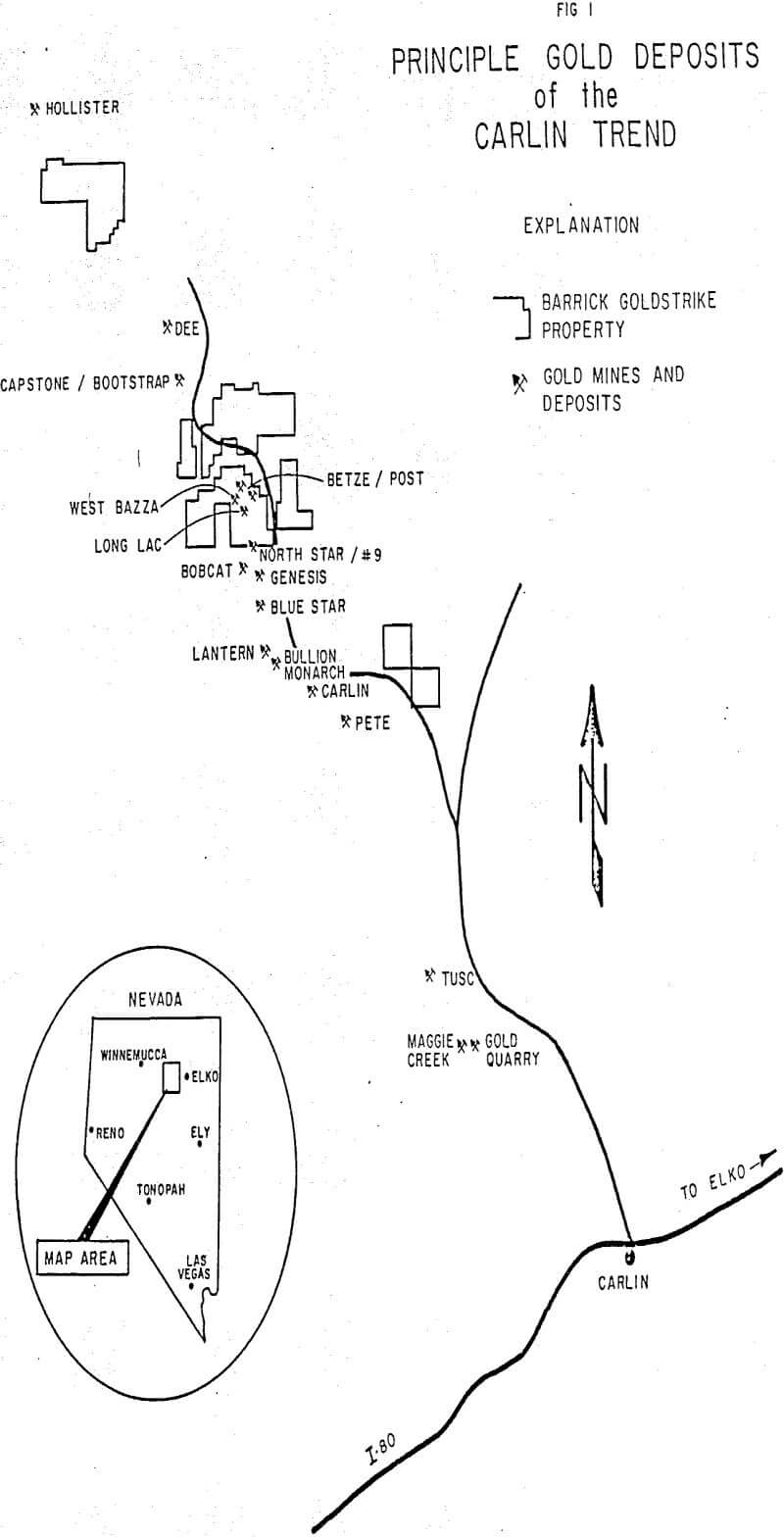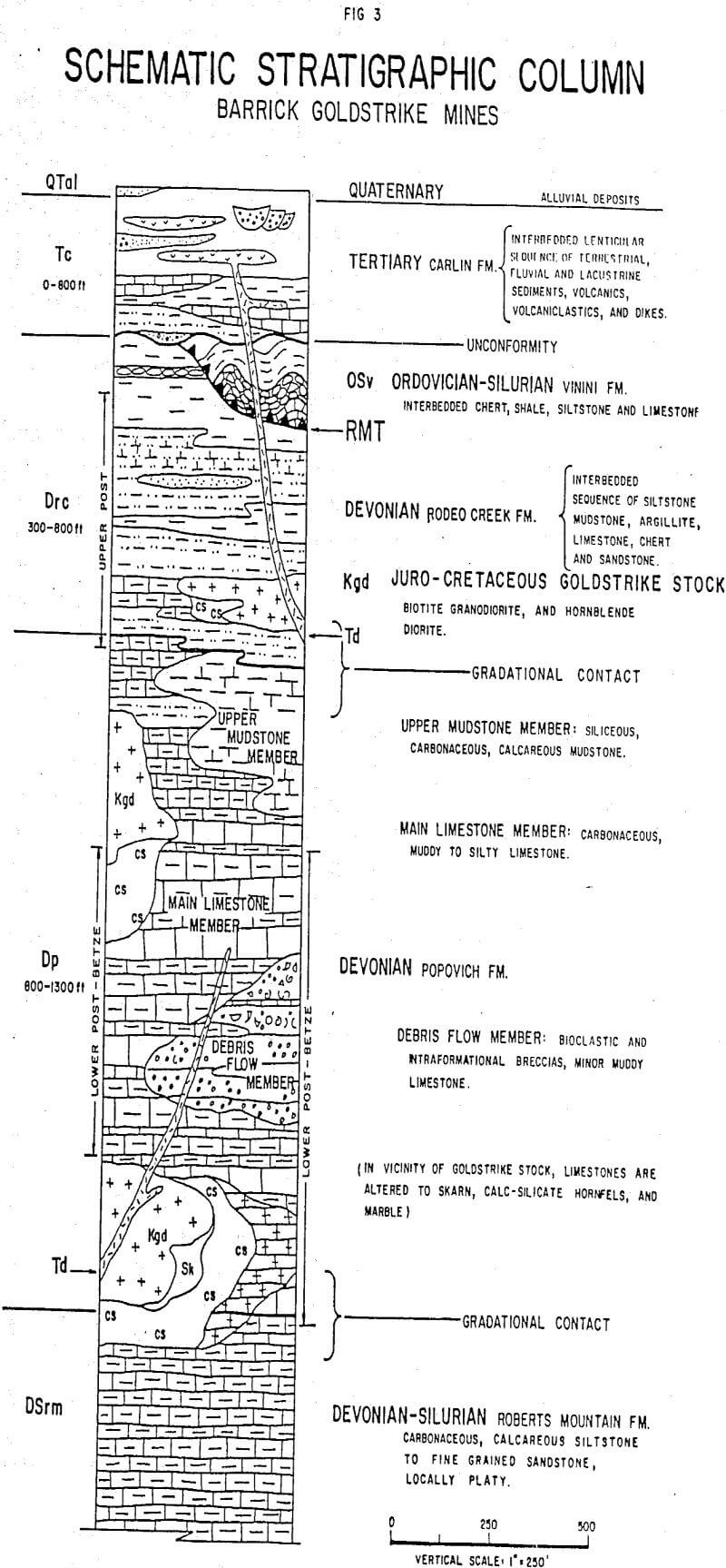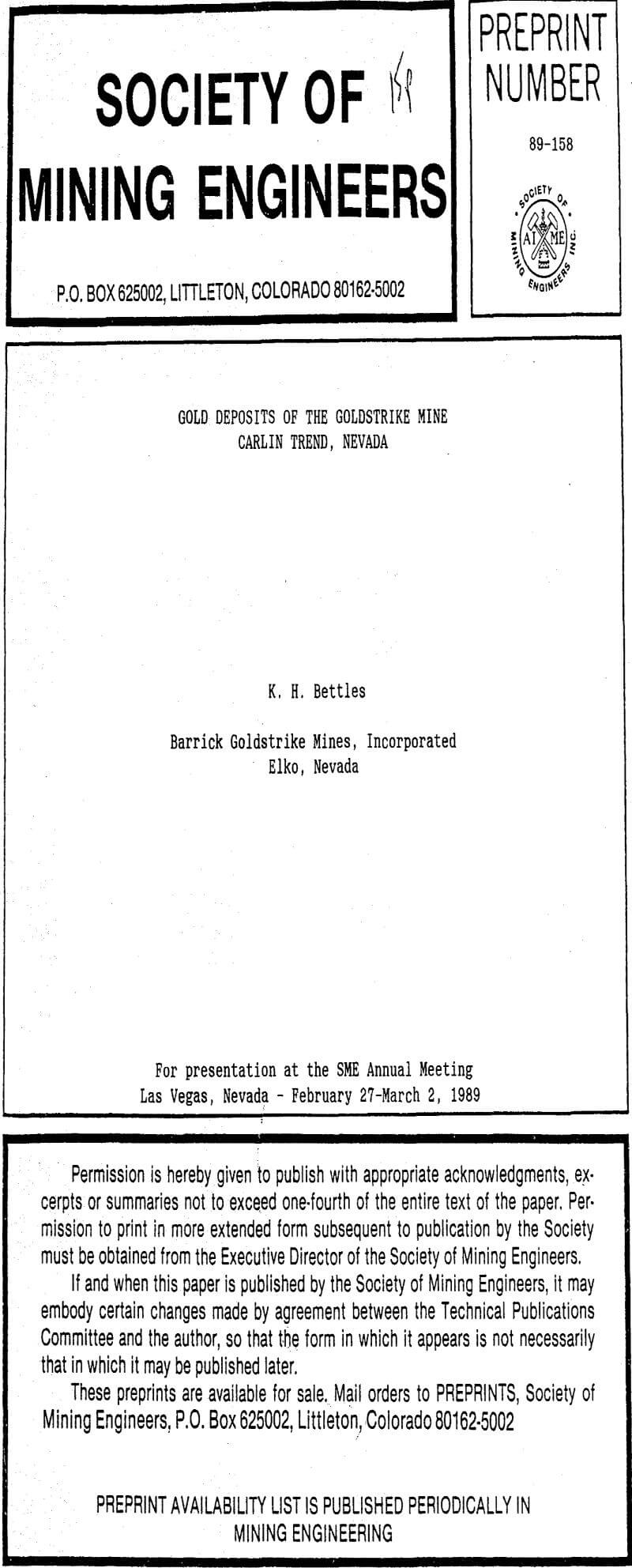Table of Contents
Stratigraphy
The stratigraphic sequence in the Carlin Trend Geological area is Lower Paleozoic marine sediments and Late Tertiary tuffaceous sediments. The Lower Paleozoic sediments consist of the Siluro-Devonian Roberts Mountains Formation, the Devonian Popovich Formation and the locally named Rodeo Creek Formation. The Rodeo Creek Formation had previously been described in the mine area as the Ordovician-Silurian Vinini Formation, which had been thrust over the Popovich Formation along the Roberts Mountains Thrust. This is now thought to be erroneous due to the lack of structural evidence for thrusting, the gradational nature of the contact between the Popovich Formation and Rodeo Creek Formation and the presence of Mid to Upper Devonian age radiolaria and conodonts in rocks above the Popovich Formation.
The Lower Paleozoic units are a transgressive sequence of carbonate shelf, slope, and basin facies that have gradational contacts. The Roberts Mountains Formation consists of carbonaceous calcareous siltstones to fine grained sandstones. It is only found in the subsurface at depths of 1,400′ to 1,500′ in the extreme northern part of the mine area. The Popovich Formation can best be described as a sequence of dirty, limestone. It occurs at depths of 600′ to 800′ below the surface and consists of medium to thick bedded carbonaceous silty to muddy limestones with interbedded calcareous siltstones and mudstones. Upper units have a higher carbon, silt and clay content. Lenticular sedimentary breccias are also common in some areas. These debris flows are occasionally fossiliferous with some graded bedding and clasts up to 1 cm in size. The Rodeo Creek Formation has diverse lithologies with a general decrease in carbonate content and grain size higher in the stratigraphic section . It consists of thin to medium bedded siltstone, mudstone, argillite with minor limestone, chert and fine grained sandstone. It outcrops at the surface in the mine area.
Intrusive Rocks
Intruding the Lower Paleozoic Sediments is the Goldstrike stock, a Juro-Cretaceous diorite to granodiorite intrusive. (Fig. 4). The stock covers about one square mile in outcrop, but is more extensive in the subsurface. It is quite variable in composition with some zones showing evidence of absorption of carbonate. Metasomatism has developed exoskarn in the calcareous sediments, up to 200′ from the contact, plus a more limited zone of endoskarn in the intrusive. Skarn minerals are diopside, garnet, epidote, quartz, calcite wollastonite, and pyrite. Minor base metal and possibly some gold mineralization is related to the skarn. Marble and calc-silicate hornfels extends to greater distances from the contact. Dykes and sills extending several hundred feet from the intrusive are common and are found locally at greater distances along structural zones. Quartz monzonite and monzonite sills and dykes of probable Tertiary age are common and are both pre and post ore. Detailed study of the intrusive rocks and age dating of the intrusives and gold mineralization are in progress. At this time the gold mineralization is believed to be considerably younger than the Goldstrike stock.
Structure
Stratigraphic units have gentle dips except in the vicinity of high angle faults where bedding attitudes may be steep to vertical due to drag folding (Fig.5). Gentle antiforms which may be due to hydrothermal doming occur in the Post, Betze and Long Lac areas. Faults are common throughout the mine area resulting in extensive fracturing, with localized zones of shearing and brecciation. Dips are generally high angle, but low angle faults also occur. Displacements are generally normal though drag folding in some cases indicates reverse movement. Total displacements are moderate, generally less than 200′ , but sufficient to produce a horst and graben structure in the Post/Betze area. Major fault directions are NW to NNW and NE. NW and NNW faults generally dip 70 – 85 degrees to the NE while the NE faults generally dip. 70 – 75 degrees to the NW and usually offset the NW to NNW faults. N-S and E-W-faults also occur.
Alteration
Silicification, argillization, pyritization and decalcification are the predominant alteration types at Goldstrike. Alteration is spatially controlled by structural zones and favorable lithologic horizons. Alteration extends to over 2000′ below the surface in the Post area, with silicification becoming predominant with depth. Silicification occurs as pervasive silica flooding followed by at least two stages of quartz veins and stockwork veinlets. At Post and Lower Post, argillization postdates much of the silicification and is frequently associated with faults and fractures which cut across the massive zones of silicification, while at Betze silicification is predominant. Argillization is more extensive at shallow depths, particularly in areas of oxide mineralization, such as at Post and Long Lac. Kaolinite is the dominant clay mineral in mineralized zones, with an increase in proportion of illite, which may be of sedimentary origin, distal to mineralization. Momtmorillonite and sericite also occur, particularly in the intrusive rocks. Pyritization occurs with both silicified and argillized zones. The average pyrite/marcasite content of ore grade zones is 5%. Pyrite is also common outside mineralized zones and.is of both hyrothermal and diagenetic origin. Carbon occurs in mineralized zones but is more common on the periphery of mineralization, as a front of remobilized carbon.

